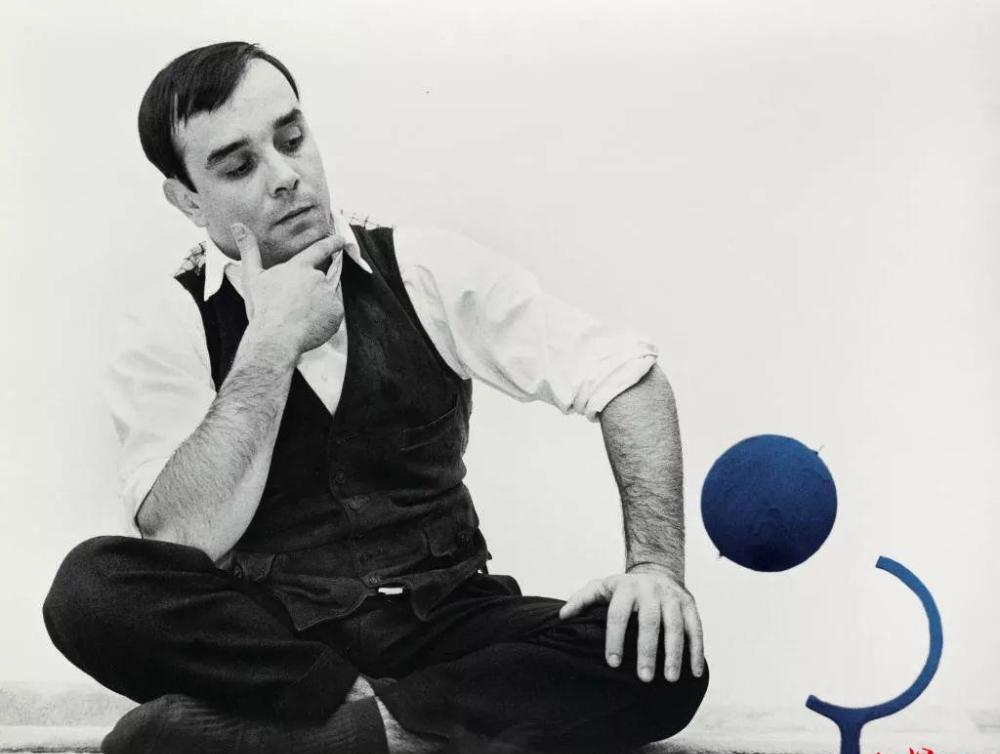In April 1958, the famous French artist Yves Klein held an exhibition in Paris with the theme of "The Void". The exhibition hall was cleaned in advance, the four walls were painted pure white, and the exhibition hall was empty.
By having a French cabinet minister on the guest list, Klein managed to get two guards heavily armed to stand on either side of the gallery entrance, with nearly 3,000 distinguished guests arriving as promised, and the streets filled with curious crowds to see what a sensational exhibition it was. The artist himself, dressed in a dress, personally guides people into empty galleries.

Yves Klein and his Blue Planet (Star Sculpture 7)
Most people laughed and left, but some people stopped by. The famous writer Camus also came to the scene and stayed in the scene for a while. Before leaving, he wrote in the guest guestbook: "Although empty, it is full of power. ”
Since then, Klein has also "sold" several "works of nothingness" in the exhibition and demanded that collectors pay for it in pure gold. More than 60 years later, a receipt he wrote to a collector who had collected the "art of nothingness" was about to be auctioned at Sotheby's, estimated at 500,000 euros (about 3.5 million yuan).
Yves Klein,Untitled Monochrome Blue (International Klein Blue No. 67)
Speaking of Yves Klein (1928-1962), many people first think of the "Klein Blue" that is famous for him. In 1956, Klein, with the help of chemist Edward Adam, began suspending ultramarine dyes in petroleum extracts, waiting for the pigments to dry, and then refining a very pure dark blue color, which was later patented "International Klein Blue".
Klein believes that blue itself symbolizes the sky and the ocean, symbolizing the boundlessness and immaculate purity. As a legend of european avant-garde art in the mid-20th century, he brought a whole new concept to art history with a monochromatic picture of large pure deep blue: pure color rather than pictures and brushstrokes can also be regarded as art itself, not just paint.
In 1957, Klein released 1,001 blue balloons filled with helium in Paris's most prosperous district of Saint-Germain-des-Prés, allowing his blue to rise slowly and blend into the endless blue sky, which he named "Sculpture in the Air". Klein and his blues have been a hit ever since.
"Aerial sculpture" composed of blue balloons
In fact, "nothingness" is also an extremely important keyword in Klein's artistic life. This concept is related to the fact that he had studied judo and was influenced by Japanese Zen Buddhism. "Discovering the body in mental space" is the key to understanding Klein's many of Klein's artistic ideas.
The receipt that Sotheby's will auction is one of the few that has been handed down more than 60 years ago. The maverick and bold artist also imposed conditions on collectors at the time—as part of this "work of nihilistic art," by burning receipts and making the last bit of physical evidence of this conceptual art disappear. At the same time, Klein will also throw half of the money he received, the gold, into the Seine...
Receipt for "works of art of nothingness"
The first owner of the receipt at the auction was an art dealer, Jacques Kugheri, who decided to abandon the performance art and treasure it. Later, this receipt was also borrowed and exhibited in many famous art museums.
Another of Yves Klein's masterpieces was a one-day newspaper he edited in 1960, with a front-page headline of Klein "taking off" from a small building. The photography, titled "Leap into the Void," is actually a photographic work in which Klein found a friend from the judo gym to stand on the ground and pull a cushion to catch himself, and asked a photographer friend to help him fix the scene from the photo — the earliest "P-figure" artwork, and his "leaping" is one of the most iconic art events of the 20th century.
Yves Klein's famous "Leap into the Void"
In June 1962, Yves Klein died of a third heart attack at home at the age of 34. Shortly before that, Klein had told a friend, "I'm going to be in the world's biggest studio [after I die], and I'm just going to do invisible work." ”
Red Star News reporter Qiao Xueyang
Edited by Li Jie
(Download Red Star News, there are prizes for the newspaper!) )